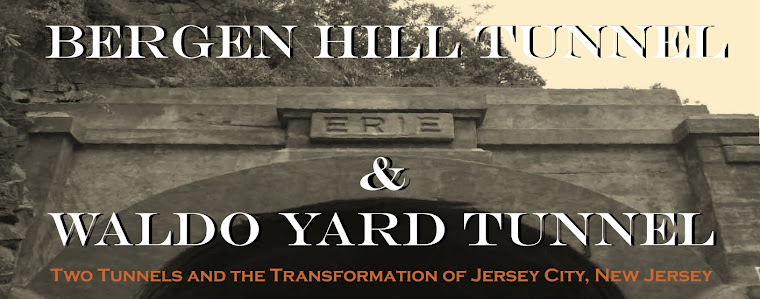Major eastern railroads vied for a place along the New Jersey side of the Port of New York. The Paterson and Hudson River Railroad (P&HRRR), chartered in 1833, accessed the riverfront via the Bergen Cut by agreement with the NJRR in 1838.
In 1852, the larger New York & Erie Railroad (NY&ERR), in search of its own route to the Port of New York, leased the P&HRRR and ran its own trains to the Hudson by way of the Bergen Cut.(1) The arrangement allowed the NY&ERR to form the first direct railroad link between the Great Lakes and New York Harbor. The Morris & Essex Railroad (M&ERR) made its own connection with the NJRR in Newark in 1853 to allow its trains to travel to Jersey City by the same route.(2)
With toeholds in Jersey City, the railroads provided the catalyst for Jersey City's industrial and residential growth and came to dominate the city physically, economically, and politically.(3) They moved aggressively to improve their advantage over their competitors by acquiring waterfront property, expanding terminal facilities, increasing capacity, and blocking rivals from doing the same. The Bergen Hill Tunnel represented the first successful effort by a competing railroad company to open a second route to the edge of the Hudson River over its own tracks in 1861. Not to be muscled out, the Central Railroad of New Jersey (CRRNJ) managed to circumvent the Bergen Hill and build a line into Jersey City in 1864 by running tracks around the bottom of the hill at Bayonne, New Jersey. But this route required the CRRNJ to build nearly two miles of expensive trestle across Newark Bay and to fill in vast mudflats to erect its terminal.(4) The Delaware, Lackawanna, and Western Railroad (DL&WRR) wanted in too, and leased the old M&ERR to gain control of that company's waterfront facilities. It then launched a project to dig its own tunnel through the hill in the 1870s. The Lehigh Valley Railroad (LVRR) acquired the Morris Canal for its Jersey City terminal.(5) Eventually, the giant Pennsylvania Railroad (PRR) achieved its long-sought-after outlet to the Hudson River through the Bergen Cut by leasing the C&ARR's and the NJRR's successor company, the United New Jersey Railroad and Canal Company (UNJRR&C Co) in 1871.(6)
To link all of these independent railroads together and gain access to various shippers in the port area, two short lines were built running up and down the eastern base of the Bergen Hill. They included the National Docks Railway (NDR) and the New Jersey Junction Railroad (NJJRR). The tiny Waldo Yard Tunnel formed the final link between the two short lines, but its construction launched one of the last major battles between railroads over their control of commerce in Jersey City.
Footnotes:
For full bibliographic citations, click on the Bibliography page.
1. Hungerford 1946: 132-133
2. Taber 1977: 50
3. Cunningham 1997: 250-265
4. Cunningham 1997: 197-198
5. Cunningham 1997: 199
6. Burgess and Kennedy 1949: 240


